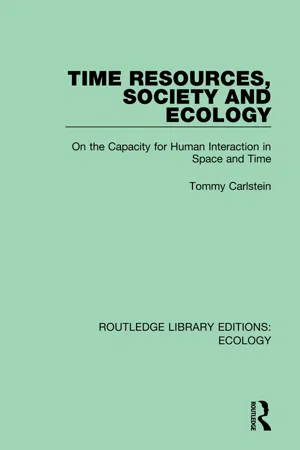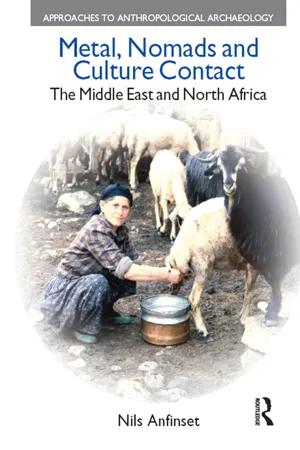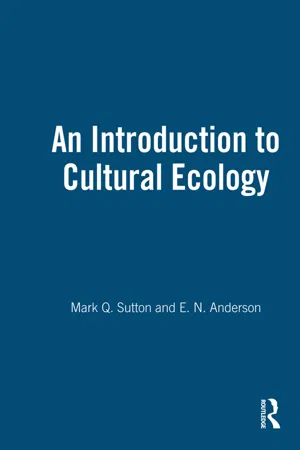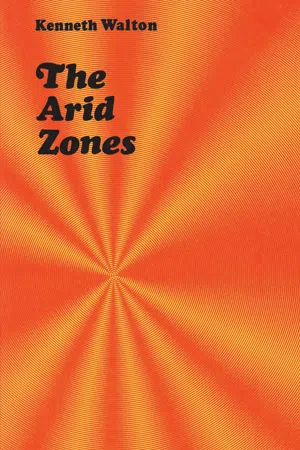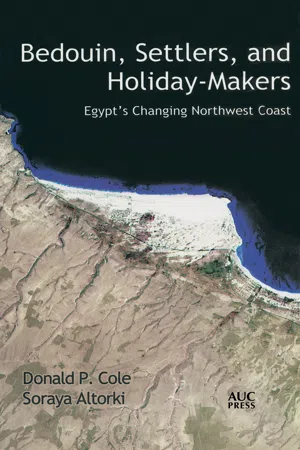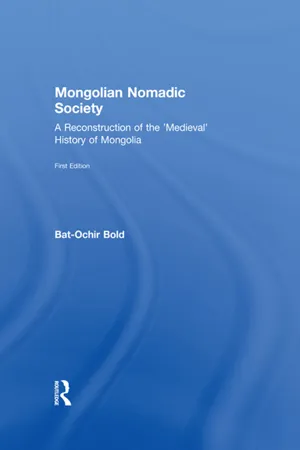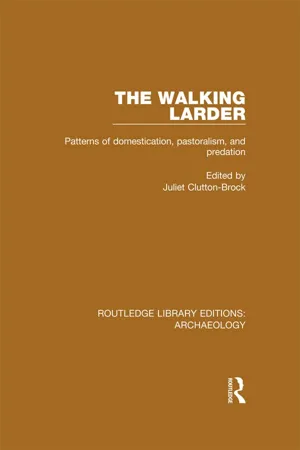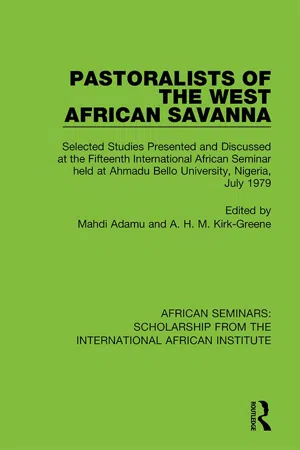Geography
Pastoral Nomadism
Pastoral nomadism is a traditional form of subsistence agriculture practiced by nomadic communities who rely on herding animals for their livelihood. These nomads move with their livestock in search of fresh pasture and water, adapting to the seasonal availability of resources. This lifestyle is often found in arid and semi-arid regions where sedentary agriculture is not feasible.
Written by Perlego with AI-assistance
Related key terms
Related key terms
1 of 4
Related key terms
1 of 3
10 Key excerpts on "Pastoral Nomadism"
- eBook - ePub
Pastoral land management
Land Tenure and Natural Resource Management in the Arid Lands Of Kenya
- Michael K. Biamah, Wilson K. Yabann, Elijah K. Biamah(Authors)
- 0(Publication Date)
- Dolman Scott Publishing(Publisher)
Chapter One1. Pastoral Land Management in Kenya
1.1 Background of Pastoralism 1.1.1 Pastoralism and Pastoral LandsPastoralism is the most predominant form of livelihood for arid lands communities in Kenya. Pastoral communities in Kenya belong to closely knit tribal groups with a history of conflicts over pasture and cattle rustling. The people are predominantly semi-nomadic or nomadic pastoralists with a recent emergence of sedentarized agropastoralists. The ability of pastoral communities to survive through periods of drought has been highly dependent on their capacity to spread their risks, to move on to new areas of grazing as resources are depleted (mobility and tracking), and to take advantage of highly diverse dryland environments (riverine woodlands, hilltop forests), and dispersed watering points. Extensive seasonal movements in response to scarcity or abundance of resources have featured prominently as part of pastoral survival strategies.Pastoral land use patterns are predicated upon risk spreading and highly flexible mechanisms such as mobility, communal land ownership, multiple herd species (herd diversity), herd separation or splitting. These mechanisms are both ecologically and socioeconomically viable options in the adaptive and survival strategies of nomadic pastoralists. Nomadic pastoralism in Kenya is epicyclical and based on an intricate information base generated locally and passed through generations. This indigenous knowledge base is dynamic and ever changing through indigenous creativity and innovation. Whereas conventional range management would opt for an adjustment in livestock numbers according to the existing land resource base, nomadic pastoralists would prefer to seek access to natural resources needed to sustain their livestock elsewhere rather than reduce their herd size. This strategy involves seasonal migration of both humans and livestock between distinct wet and dry season grazing areas. This opportunistic process of herd mobility and tracking is a logical and tactical strategy of access to non-exclusive tenure. - eBook - ePub
Time Resources, Society and Ecology
On the Capacity for Human Interaction in Space and Time
- Tommy Carlstein(Author)
- 2019(Publication Date)
- Routledge(Publisher)
Roughly speaking, nomadic pastoralism is practicable in areas where the growing season is too short for domestic plants to mature due to lack of rainfall or where it is too short for other reasons such as low temperatures. Rough and sloping terrain may be another impediment to agriculture. As far as rainfall is concerned, it is not only the duration of the rainy season that matters, but also the amount, reliability and distribution of precipitation. As a habitat gets increasingly marginal, the shorter the growing season and the more patchy the vegetation becomes, patchy both in a spatial and temporal sense. The same is the case with water supply. This principal difference between agriculture and Pastoral Nomadism is illustrated in Figure 4:1. While agriculturalists use land by staying put in one local area, at least during the time of cultivation, the pastoralisťs use of marginal regions assumes movement between local areas, often on a very short-term basis. By such movement, pastoralists can procure enough vegetation for their herds on a regional scale although there may not be sufficient pasturage locally for more than a short time. The path of movement, however, is not only a function of the availability of vegetation or water but even more so the coincident accessibility of these resources. It is thus common that plentiful vegetation is ungrazed for lack of water within range, or vice versa and worse, that local overgrazing and over-intensive use of land results from the accessibility to water. As shown in Figure-4:1, the precondition for the exploitation of marginal niches and habitats is that of mobility. Those who tend the animals must lead a life with a more or less nomadic slant, and they must be prepared to allocate their paths to those times and places (regions and seasons) where this ecotechnology is applicable and viable, although this might entail forms of fission and fusion which are less desirable on purely social grounds - eBook - ePub
Metal, Nomads and Culture Contact
The Middle East and North Africa
- Nils Anfinset(Author)
- 2016(Publication Date)
- Routledge(Publisher)
5 The Role of Nomadic Pastoralists As discussed in the earlier chapters, the natural environment and climatic changes such as rise in annual rainfall during the 5th and 4th millennia BC had a direct effect on the extent to which it was actually possible to pursue nomadic pastoralism. In this chapter, the role of pastoral nomads will be considered both in a contemporary and a past setting in relation to northeast Africa and the southern Levant. There will also be references to both ethnographic and archaeological examples outside this region to provide a better understanding. Pastoral nomads will be considered on a very broad and general level, implying a specialization in animal husbandry and involving shorter or longer seasonal movements. In other words, nomadism is a way of life with a large degree of economic specialization, where cultural values are moulded in a mobile household. The ethnographic examples play only a minor role here, as the intention is to develop a general understanding of nomadic pastoralism within the region. The first part takes a closer look at the most recent and present context of Pastoral Nomadism in the region: types, production and consumption, social organization and values, as well as pastoral nomadic trade and links to sedentary societies. Thereafter, the manner in which pastoral nomads may be traced in the archaeological record is considered. Lastly the 5th and 4th millennia in both northeast Africa and the southern Levant will be evaluated in relation to some smaller cases of evidence. Key questions addressed in the last section of this chapter include to what degree secondary products (milk and wool) could have been utilized before the domestication of the donkey and camel during the 5th or 4th millennia and the role this had in both northeast Africa and the southern Levant. Sedentarization is also a central process when referring to pastoral nomads past (e.g - eBook - ePub
- Mark Q. Sutton, E. N. Anderson(Authors)
- 2020(Publication Date)
- Routledge(Publisher)
8 PastoralismPastoralism is that form of agriculture in which the practitioners specialize in, and obtain their primary subsistence from, the husbandry of one or a few domesticated animal species. These species are invariably herbivores: cattle, horses, sheep, llamas, alpacas, goats, camels, reindeer, and similar animals. Plant cultivation often forms one component of pastoralism but is not generally dominant. In some cases, however, such as reindeer, the species of focus is not domesticated.A precise definition of pastoralism is elusive, with the primary disagreement centering around the proportion of horticulture to agriculture in the economy and the degrees of mobility (see Krader 1959:499; Khazanov 1984:7, 15–17; and Cribb 1991:15–17, 20; also see Spooner 1973; Weissleder 1978; and Goldschmidt 1979). The term “nomad” has generally been used by anthropologists to refer to mobile pastoralists and should not be applied to hunter-gatherers (see Krader 1959:499). A brief history of the study of pastoralists has been presented by Neville Dyson-Hudson (1972:2–7; also see Waller and Sobania 1994).Pastoralists and their animals have developed a long-term mutually beneficial relationship (see Krader 1959:501). Animals provide humans with products such as meat, milk, hide, dung, wool, and labor and with services such as companionship and the transportation of people and goods. Humans provide animals with protection from predators, a steady food supply, health care, an expanded habitat, and assured reproductive success.Pastoralism requires a great deal of land as a pasture base. It is generally more productive (calories per acre) than most hunting and gathering but less productive than farming. However, pastoralism can be very efficient in areas unsuitable for farming. Pastoralists utilize their animals to convert unusable biomass from one trophic level into usable products at another trophic level: Grasses that humans cannot digest are converted into milk and meat that they can eat. Even though using the animals involves an additional trophic step, it is highly efficient in such circumstances because people cannot use the grasses anyway. However, the use of supplemental feed, such as corn, that humans could directly consume is a very inefficient use of resources, and few pastoralists do it. - Eugene Costello, Eva Svensson, Eugene Costello, Eva Svensson(Authors)
- 2018(Publication Date)
- Routledge(Publisher)
First of all, it is of essence to distinguish participants in transhumance from other kinds of pastoralists, that is to say, anyone “whose livelihood comes from tending grazing animals” (Gefu & Gilles, 1990: 35). Anatoly Khazanov’s (1994) attempt to classify various types of pastoralism is of much relevance here. Nomadic pastoralism, in its purest form, is characterised by a complete lack of agriculture (in the sense of arable farming), and in modern times is recorded only in North Eurasia, High Inner Asia, the Eurasian steppes, Arabia and the Sahara (Khazanov, 1994: 19). Moreover, people involved in full nomadic pastoralism lack a fixed base, so confusion with transhumance should not arise in this case. Less clear-cut, however, are the differences between the latter and what Khazanov (1994: 19) calls ‘semi-nomadic pastoralism’. This is much more widespread around the globe and involves some element of agriculture along with the periodic changing of pastures throughout most or all of the year. Other variations of pastoralism have been identified too. In ‘semi-sedentary pastoralism’ and ‘distant-pastures husbandry’, arable farming constitutes a more important element in the economy and as a consequence not everyone in the community moves with the stock under these systems (Khazanov, 1994: 21–23). In Central Asia, for instance, the Kirghiz are described as semi-sedentary in the late nineteenth century because their migrations with livestock took place over only three to three and a half months every year, with most family members remaining behind due to agricultural commitments (Simakov, 1978: 24). Both Johnson (1969: 18–19) and Khazanov (1994: 23) complain that scholars are too liberal in what they label ‘transhumance’, pointing to some vertical (lowland–upland) livestock movements in Europe which might better be described as semi-nomadic. This seems unduly fastidious, however. When talking about pastoralism, researchers really have in mind a broad spectrum of livestock management. That spectrum ranges from, on the one extreme, a community having no arable at all and continually re-locating over the course of a year to, on the other, full sedentism with a dependence on arable, and livestock being kept year-round on the one farm supplemented by fodder. If one considers that transhumant strategies occupy what is roughly the middle of this pastoral world, it is unsurprising that a close definition is impossible.- eBook - ePub
- Hilton Kramer(Author)
- 2017(Publication Date)
- Routledge(Publisher)
7 Pastoralism—A Basic Dry-Land ResponseThe green spots and strips of irrigation cultivation seen on a satellite photograph of the arid lands occupy a much smaller area than other types of land-use. Dry farming has been shown to fill in some of the gaps but by far the most ubiquitous economic response to dry lands is pastoralism. Pastoralism, however, embraces many ways of life and standards ot living. At one end of the scale is the wealthy rancher of cattle or sheep in the USA or Australia who produces beef and hides, mutton and wool as a commercial enterprise with a title to hundreds of square miles worked from a permanent base and providing paid employment for a few tens of people. This way of life is far removed from that of the nomads of the Old World whose objective is subsistence for themselves and their families. There are, in fact, as many different forms of pastoralism as there are methods of cultivation in the arid lands. Pastoralism is also a way of life which has been subject to rapid changes in scale and distribution, changes which have been initiated by changes in the environment, as through climatic change or rainfall variability, or through social, economic and government pressures.Evidence from the Old World points to south-west Asia as the area in which animals were first domesticated although as yet there is no absolute agreement as to the ways in which this was achieved. Some believe that in areas where game was relatively scarce, as in most of the arid lands, there was an incentive to capture and to keep the animals alive until they were required for food. Others prefer the concept that, in the period of desiccation which followed the pluvials of the glacial periods, man and animals were drawn together by common need at water points and that from this unity of interest in survival there was the opportunity for domestication. In more humid areas where game was plentiful quite large communities could live above day-today subsistence level and have the leisure to elaborate the arts depicted by the prehistoric inhabitants of the caves at Lascaux in France, at Altamira in Spain or by the rock paintings of the Ahaggar in the Sahara. In such localities and under such climates there was less incentive to domesticate since a ready supply of comparatively slow-moving animals was available provided that population increase did not outstrip local food supplies. - eBook - ePub
Bedouin, Settlers, and Holiday-Makers
Egypt's Changing Northwest Coast
- Donald P. Cole, Soraya Altorki(Authors)
- 1998(Publication Date)
- The American University in Cairo Press(Publisher)
Matruh also provided Nile Valley Egypt with a third or more of the mutton consumed there until the 1960s, with the remainder raised in the delta or imported from Libya and Sudan (Mohsen 1975:14). Finally, most of the wool shorn from the region’s sheep eventually reached textile factories in the Nile Valley, where it was woven into carpets. The old pastoralist production, in part, was a subsistence-oriented system organized by kindreds. However, long before it was transformed in the 1960s and the decades that have followed, the old system was firmly linked by trade and other market relations to the Nile Valley. It was also characterized by the existence of a few relatively large-scale livestock owners, many small-scale pastoralists, and some with no or almost no animals of their own.The New Bedouin Ranching
We have mentioned severe droughts in the 1950s and early 1960s that seriously affected Bedouin in different parts of the Arab world. Arab states mainly responded to these crises by sedentarization projects and by the distribution of subsidized fodder. More or less coincidental with the droughts were numerous other changes that had impacts on range-based livestock- raising. These include an increased flow of money within the region as a result of the sale of oil, rapid urbanization and population growth, increased demand for meat, and widespread use of motor vehicles.When rain again fell on the parched steppes and the droughts eased, the old tribally organized and controlled pastoralist system was not fully reestablished on Arab ranges. A more individually organized and commercially oriented system emerged. We consider this new system to be a form of ranching. As in anthropologist Arnold Stricton’s (1965:230) definition of ranching, the new system is a“pattern of land use . . . based on the grazing of livestock . . . for sale in a money market.”The second part of his definition that mentions“control over large units of land, extensive use of that land, and extensive use of labour on the land”applies to the Euro-American ranching complex but not to the situation on Arab ranges. Thus, we speak of Bedouin - eBook - ePub
Mongolian Nomadic Society
A Reconstruction of the 'Medieval' History of Mongolia
- Bat-Ochir Bold(Author)
- 2013(Publication Date)
- Routledge(Publisher)
Otor migration is a method of using pasture land in which close-lying pasture is held in reserve and distant pastoral regions are used without a cumbersome moving of the entire household. Livestock keepers allow their animals to graze at a location until the pasture is exhausted, and then they move on. This form of migration has been known since at least the thirteenth century.PRODUCTION ACTIVITY OF LIVESTOCK KEEPERSGeneral livestock keeping work Expenditure of labourThe close connectedness of nomads to nature via their herds and the pasture influences their expenditure and time of labour. In general, expenditure of labour in nomadic livestock keeping is low. In the case of some activities it is not clear whether they should be reckoned as production labour or as familial work. The difference between free time and working time is relative. In comparison to the production activity of peasants engaged in agriculture or horticulture, the work of nomadic livestock keepers is very specific. In the eyes of Europeans, or of agricultural workers, such work is incomprehensible. For this reason, words such as ‘primitiveness’ and ‘laziness’ occur frequently in the reports of travellers familiar with peasant culture. A classic example of this is I. M. Maiskii, who dealt with this theme at the beginning of the twentieth century. He writes:The main characteristic and the basis of the mentality of the Mongols is undoubtedly passiveness. This is a result of the natural environment and of the people’s history … Passiveness, which from the viewpoint of Europeans is somewhat strange and incomprehensible, is to be seen everywhere. When one considers their state or economic organisation, their religious belief or their laws and customs, one finds everywhere, literally everywhere, submission and indifference. It could be that these characteristics are more marked in the area of livestock keeping than in other areas … The form of Mongolian livestock keeping at present is extremely primitive. In the true sense of the word, it is a prehistoric form which requires hardly any human labour … - eBook - ePub
The Walking Larder
Patterns of Domestication, Pastoralism, and Predation
- Juliet Clutton-Brock, Juliet Clutton-Brock(Authors)
- 2014(Publication Date)
- Routledge(Publisher)
Fig. 19.1 ).Ingold (1980) has argued that the change from hunting to pastoralism is not simply a shift in ecological relations from herd pursuit to herd management (contra Foley 1982), but it involves a major transformation in the social relations of production and the ideology of prestige. Pastoralism is based on the principle of divided access to living animal resources, i.e. the ownership of animals, while hunting rests on the principle of collective access where an animal becomes someone’s property only with its death.1 A pastoralist gains prestige by accumulating wealth on the hoof, but for the hunter it is the demonstration of his skill and his generosity in distributing the meat from his kills which win him respect. Thus, archaeological sites which document a combination of pastoralism and hunting appear from this theoretical perspective as surprising phenomena where the implied contradictions in the social relations of production and prestige require explanation. This impression is reinforced by a perusal of the ethnographic literature on the pastoral peoples of East Africa, in which hunting is, as a rule, very rarely mentioned. Could it be that the archaeological sites document not only a system of subsistence no longer extant in East Africa (Gifford Gonzalez 1984) but also, perhaps, different cultural attitudes towards animals? To answer these questions we need to look more closely at the ethnographic evidence.Figure 19.1 Location of sites yielding bones of both domestic stock and wild animals.Many ethnographies of pastoral peoples either completely tail to mention hunting or remark simply that it is a rare activity, perhaps resorted to more often in times of severe drought (e.g. Carr 1977, p. 200). For some groups, wild animals are only of interest in their relationship to domestic livestock: for the Nandi ‘wild animals are of two kinds: those that injure livestock and those that do not’ (Huntingford 1953, p. 127). Not only is hunting a rare activity for many pastoralists, it is also regarded with some contempt: the Nuer insist that only the absence of cattle makes a man engage in hunting other than casually (Evans Pritchard 1940, p. 73). Among the Turkana the word ‘hunter’ (egulokit ) is almost synonymous with that for a poor man (erkeboton - eBook - ePub
Pastoralists of the West African Savanna
Selected Studies Presented and Discussed at the Fifteenth International African Seminar held at Ahmadu Bello University, Nigeria, July 1979
- Mahdi Adamu, A. H. M. Kirk-Greene(Authors)
- 2018(Publication Date)
- Routledge(Publisher)
Given the number and importance of pastoralists as users of the land, surprisingly little is known about the economics of pastoralism. Many pastoral societies have been studied by social anthropologists, who have provided information on social and political organisation, and livestock marketing is the subject of several economic studies. But the economics of production in traditional pastoral societies in West Africa and elsewhere has been largely ignored. As a result, studies of pastoral social structure are forced to generalise about the economics of pastoral production, and economic development planners are obliged to make hazardous assumptions about how pastoralists will react to incentives, plans and changed circumstances.This state of affairs is surprising. In West Africa, for example, pastoralists (defined as people for whom pastoral activities including, where appropriate, caravan transport earnings, provide more than half of total (subsistence and marketed) gross income, or for whom milk and milk products provide more than 15 per cent of food energy consumption) number between four and five million, and are almost the only people making economic use of between 25 and 75 per cent of the land (Swift 1979a). Elsewhere in Africa, the Middle East and Asia, pastoralists are also the main or only users of very large land areas. Pastoralists are everywhere important in wider national and regional economies; they are conspicuous, at times politically powerful; they have attracted a large share of some types of research and a great deal of general curiosity and speculation; they are currently accused of large-scale ecological destruction, of being ‘not so much the son of the desert as its father’; and, in the last decade, unknown but quite large numbers of them have died in a series of African famines of a severity unknown since those of Ireland and Bengal.PASTORAL ECONOMIESThe general nature of pastoral economic processes and household-herd relationships have, however, occupied an important place in pastoral studies. Barth (1964b, 1973) was the first to make explicit a number of important consequences of the fact that pastoral capital consists principally of herds of domestic animals. He pointed out that, in a pastoral economy, (a) essentially all productive capital is in consumable form: livestock can be eaten at any time, which means that the main productive asset of a household may be consumed at any time without the necessity for its conversion through a market; (b) saving and investment are necessary in all circumstances: renewal of the herd capital is possible without the benefit of any economic institutions, since a significant fraction of the income of a pastoral operation is in the form of capital gains, that is, female animals.
Index pages curate the most relevant extracts from our library of academic textbooks. They’ve been created using an in-house natural language model (NLM), each adding context and meaning to key research topics.
Explore more topic indexes
Explore more topic indexes
1 of 6
Explore more topic indexes
1 of 4

